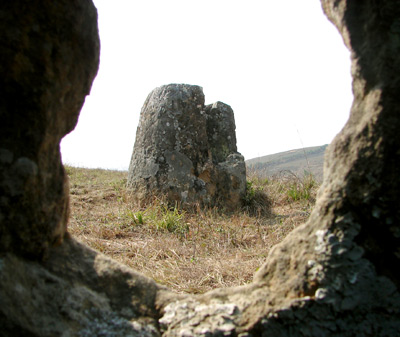|
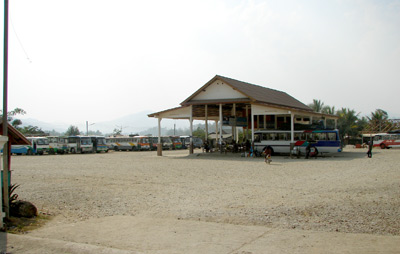 |
Sixth day in Laos
This morning I had breakfast with fried bread and
chicken soup for a change.
I left Luang Prabang from the Southern Bus Station.
85 000 Kip with the public bus.
Temporary
I was now leaving the big river behind, taking a detour
to the eastern mountain. My goal was Phonsavan, the
capital of Xieng Khuan Province. |
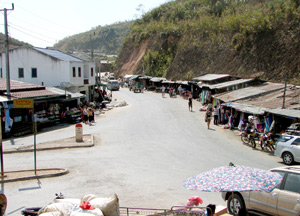 |
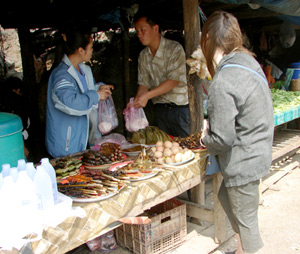 |
|
Muang Phu Khoun, Road Junction
Road junction at a small village, Muang Phu Khoun. Just a few
houses along the road but big commerce. We made a short break here
to eat local food and stretch our legs. Straight ahead you go south to
the capital Vientiane. My tour was going left and eastward to the
mountain. |
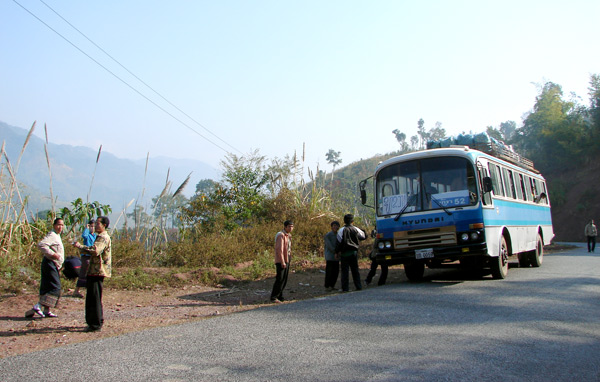 |
Newly built road
I also noticed that the roads was well paved and had nice ditches. I
later learned that this part of the road was built by the the
Chinese. The road going eastward from Phonsavan was built by the
Vietnamese but already cracking up. |
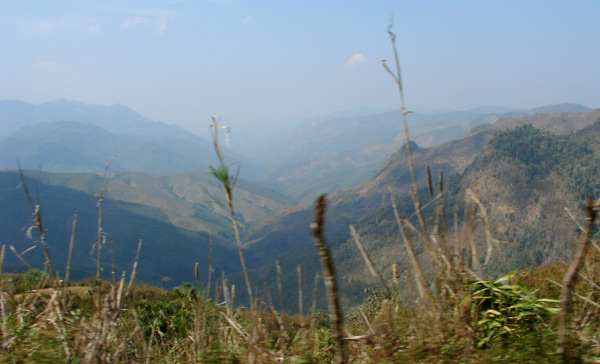 |
Steep and burned hills
The bus tour lasted 8 hours of which 7hours was going really slow up
hill until we reached the high plateau. Quite steep hills and I
noticed the many slopes looked quite bare and burned. I was later
enlightened about the reason for that. |
Xieng Khuang fact
The province holds a population of 200000 people of witch 60000
lives in the capital. Several minorities lives here on the
plateau: Lao, different Thai groups, Vietnamese and Hmong, among
others. The former capital was totally destroyed during the
Vietnamese war and was simply abandoned in 1975.
Battlefield
It has during the centuries served as a battleground for the
Vietnamese, Chinese Haw, northern Vietnamese and lately the USA.
Hmong groups has until recently, more than 30 years after the US
withdraw, had armed forces opposing the communist regime. Even
so there was rumors during my stay of a bus hijacking. I never
learned what happened. |
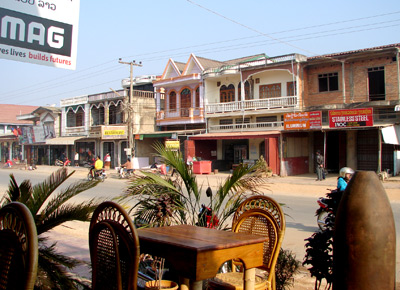 |
Phonsavan
Like all places here in Laos the colonial heritage is quite
obvious. This could almost be the American wild west in late 19th
century. The town seemed much less touristy than Luang Prabang and
gave the impression of a small city, still it held the double
population compared to Luang. Even so, the streets was newly
repaired and had paved sidewalks.Sabadhi Hotel
I got a room at the Sabadhi Hotel, meaning "Hello-hotel", at 3 US
dollar with hot shower in the room. Though, they had chickens
outside the window, with a cock that, as he is supposed to, started
to make noises at 3 am. Well, that's life!
Funny
I heard that foreigners was not allowed to rent motorbikes in the
area. Maybe to dangerous, it's not unusual that westerners hurt them
self , or maybe to many opium fields around?
The funny fact was that
we had a Japanese tourist, a painter, in our company and HE was
allowed to drive of into the mountain. Seemed that foreigners and
foreigners wasn't the same. |
Onsdag, februari 14 2007
16:49Om någon undrat så har jag läst era
mail. Tack for breven, det ar skönt med lite kontakt
med verkligheten. Om någon annan undrar hur man
skickar mail härifran sa finns det mitt i det ganska
enkla samhallet en förmaga att snappa upp
moderniteter, som tex internet cafeer. Uppkopplingen
är inte den bästa här men ändock ADSL-modem. De
flesta internetcaféer kan säkert också bränna foto-CD. Dom
är
driftiga, asiaterna. Finns det en dollar att tjäna
missar man inte det. Häromdagen bröts dock linjen i
hela staden (Luang P) medans jag skrev. Alla datorer
stod stilla nån timme. Ett annat problem är att
västerläncska mailservrar ofta tar lång tid
att nå och logga in på. Bilder är ganska otänkbart att
öppna. Bloggen är mycket enklare att använda. inte
så mycket krusiduller.
Förutom internet är tvätt en
liknande praktisk fraga. Man
kan naturligtvis tvätta sjalv, i hårschampo och
kallvatten, men lite lat är man ju. Det finns
"Laundry" överallt. 7000 Kip per kg, dvs kanske 5 kr.
Men i bland kärvar det. I helgen var jag i desperat behov av tvätt,
Jag har
tre ombyten och rest i en vecka. Fast i söndags
fanns plötsligt ingen ström i hela staden. Det gick
inte att tvätta, det gick inte att koka kaffe eller
ladda mobilen, duschen fungerade inte - inte ens
kallvattnet for det gick genom en elektrisk värmare
- och naturligtvis inget internet. Så det gick
ytterligare två dagar utan ren tvatt - fick fuska
lite i handfatet och likaså "duscha" i handfatet.
Duschar är i allmanhet coldshower,
även om man
betalar for varmvatten. Antingen fungerar inte
strömmen eller så orkar man inte vänta pa att vattnet
kansk skall
bli varmt. Ibland är det så konstiga rörkopplingar
att man helt enket inte betgriper hur varmvattnet
fungerar. Vatten ar ju en bristvara (likasa el)
och man får visa en viss respekt for det. Laos är ända
bättre än Burma och Kina där det var så gott
som 100% kallduschar.
Har nu anlant till en bergsprovins som heter
Xieng Khuang. Huvudstaden hette det samma men den
bombades så hårt av amerikanarna att den inte gick
att återuppbygga. I stället befinner jag mig i den nya huvudstaden
Phonsavan . Jag och dom tokiga
fransmännen skiljdes på busstationen, dom skulle
försöka lifta - tog flera timmar att lära Gil saga
hitch hiking - till nästa stad, i riktning mot
huvudstaden. Själv har jag som sagt tagit en
"detour" innat landet.
Det tog 8 timmar med lokala bussen varav
7 på slingriga bergsvägar - i kanske 30 km i timmen.
Tämligen obekvämt men otroliga vyer och massa små
bergsbyar pa vägen. Detta ar ett hopkok av en mängd
minoriteter men Lao dominerar. Här finns också Hmong
- det krigiska folket som fortfarande inte helt lagt
ner vapnen i sin kamp mot regimen. De stred också på amerikanarnas sida under vietnamnkriget.
Ganska grönt och halvdjungel
på vägen upp på högplatan. Ca 1200 meter högt. Runt staden
är dock
ganska kala kullar. En del skog ar nog avverkad men
jag hörde att det spreds mycket napalm över området och det kommer aldrig att växa
någonting här igen.
forts...
|
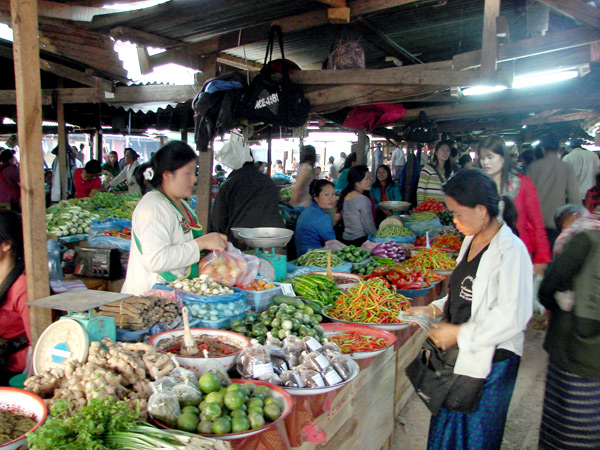 |
Local Market
The local market was as interesting as always. Clothes, cigarettes,
vegetables or a quick lunch were available here. The even sold alive animals,
a kind of raccoons, for food. |
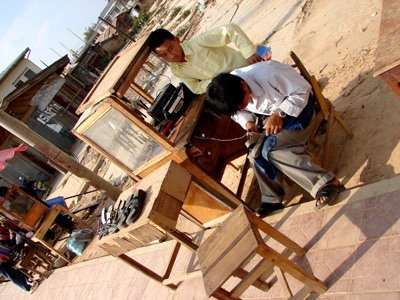 |
The Handy Man
I got trouble with my sandals. They broke down. No big deal, the
handyman on the street fixed it with a heavy needle and tread. 3
bucks for that. I got
similar memories from Africa. |
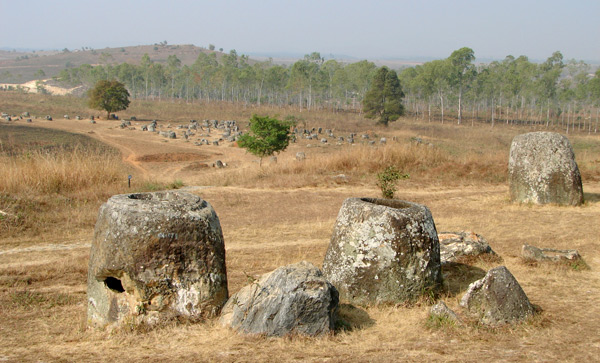
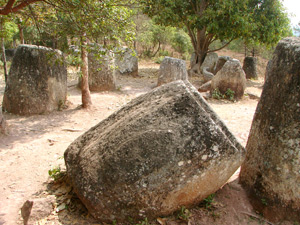 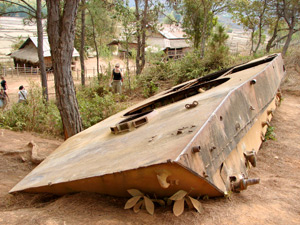 |
Seventh day in Laos
Breakfast at the Chinese restaurant. They served American
breakfast, French baguettes, Italian pizza but no Lao coffee! Well,
well...Anyway, I had one of those guided tourist tours this day, taking me to
the local attractions. 13000 Kip, to little expensive maybe, but I'm not
counting my money.Plain of Jars
One of the main reasons to visit Phonsavan is the Plain of Jars.
Prehistoric jars made of stone, and there are hundreds of
them. By whom or for what reason is still unanswered. Even their age
is somewhat a mystery. 2000 years old is likely.
The Russian Tank
As a bonus you got to see
the famous Russian tank, that 1963 got stacked into the irrigation
system and
was never released. In
recent time it has been robbed from all its exterior cause Vietnam
now pays loads for all metal. Now the local farmer wants to
keep the tank as an attraction, still making some profit from it. |
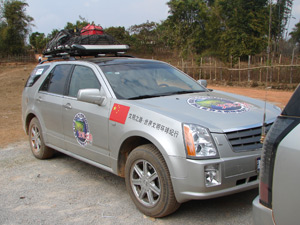 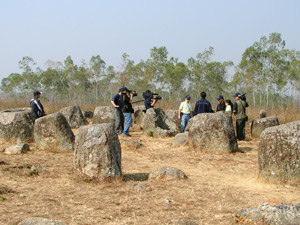 |
The Silver Caravan
A mysterious caravan of brand new shining cars was following me up
in the mountain. Not really the ordinary Toyota brand - this was
Chevrolets! Found out that this was a team from the Chinese state
television, CCTV, doing reports from famous sites in the
neighborhood. Three weeks later I found them still following me,
this time at Angkor in Cambodia. |
forts...Hans-Peter Nilsson onsdag, februari 14 2007 16:49
Mest kännt är Phonsavan för "The Plain of Jars". Ett stort område fulla
av mystiska krukor, karvade i sten. De lär vara 2-3000 år gamla
och en del är manshoga. Troligen gamla begravningsurnor. Här
finns tusentals krukor. Lika många som krukor finns det också
bombkratrar och landminor. Fortfarande idag, 30 ar efter kriget
håller man pa att rensa fälten och årligen dör männinskor som
kommit i kontakt med gamla bomber.
Kriget är således högst levande här, trots att Laos inte ens
offentligt ingick i det. I morse åt jag frukost på en restaurang
som hette "Cratern" och hade några manshöga rostiga bombskal som
dekoration på verandan.
De pågar en intensiv uppbyggnad här, vägarna
är asfalterade
och trottoarerna stenbelagda. Uppför hela bergsvägen fanns djupa
armerade diken - redan i mars börjar regnet här uppe. Elnätet
håller på att byggas ut till bondbyarna och det byggs rejäla
stenhus överallt i staden. Det tycks vara kineser och
vietnameser som bekostar bergsvägarna.
Mina fina sandaler som jag köpt i Burma for 30 kr och passar
perfekt. gick sönder idag under rundturen. Tänkte ta mig till
markanden i eftermiddag innan de stänger men på vägen gick jag
förbi några hantverkare som satt utmed vägen. De tycks laga allt
- klockor, radioapparater och SKOR. Han sydde snabbt om mina
sulor med en liten "harpun" som han stack genom gummit och
fångade upp tråden på andra sidan enligt samma princip som en
symaskin. Knappt 20 kr.
Far nog vidare mot huvudstaden i morgon om inget oförutsatt
inträffar.
hp |
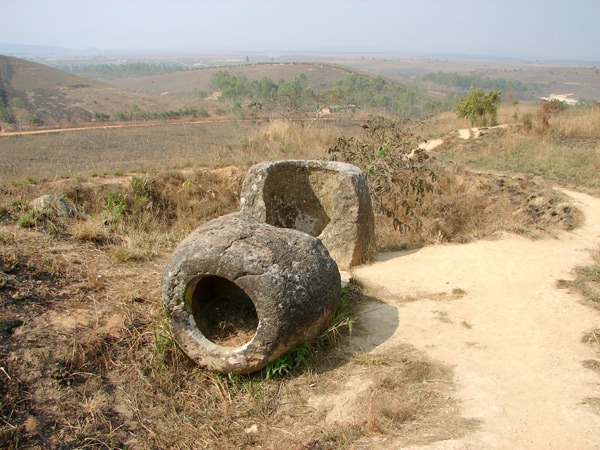 |
The Plain of Craters
The Plain of Jars turned out to tell a complete different story than
I had expected. The old jar that has been standing there for thousands of
years had finally given up for modern weapon. Behind the broken jar is the
crater of a bomb that finally caused it to crack. Everywhere around
here you see those craters, as a reminder of a tragic history that
should not be forgotten.The hillsides tells the same story. I had
noticed that many of
them looks dead as a desert. I was told by an American tourists that they
had been exposed to
napalm during the war and nothing is going to grow there again.
Ever! |
|
The Secret War
During the Vietnamese war the Americans dropt
loads of bombs over the highland. A farmer once expressed it as they
scattered bombs like a farmer strew seed.
Actually they dropt more bombs in
Laos than in Germany and Japan together during the WW II. Laos wasn't even in the war!
This is known as "The Secret War", and for a long time simply denied
by the US.
Cluster Bombs
Mines, and especially, cluster bombs is still a big problem in
Laos. 30 millions unexploded cluster bombs are estimated to lay
around in the soil.
Still 30 years after the ceasefire there are
thousands of
casualties every year in Laos. Children playing in the mud, students
walking in the schoolyard or farmers working on the rice fields.
Cattles and sheep's killed are not even counted. |
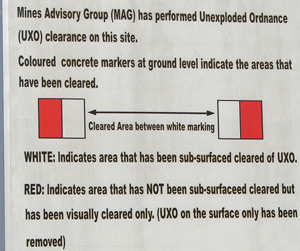
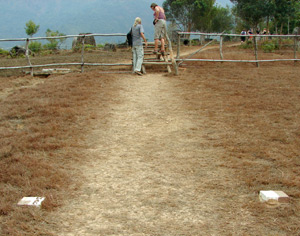 |
How to use a bombshell
The wars has left a lot of military waste in the country,
especially here in the mountains. Creative as they are, people here
has made the waste a part of there everyday life and economy. First class
metal should not be thrown away. It could be used for decoration, as
a fireplace, a bell or as a key holder.
The Chinese restaurant below is called the Crater Restaurant. |
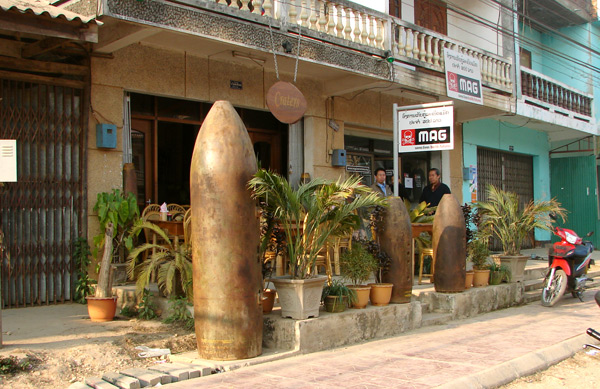
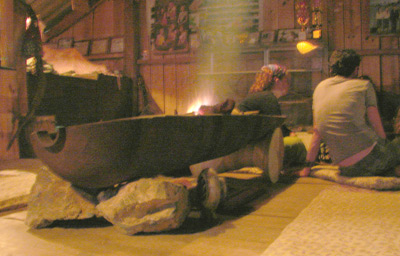 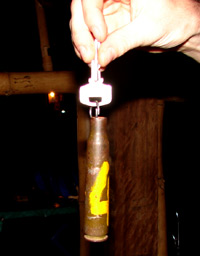
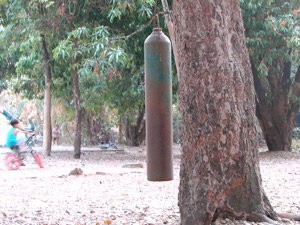 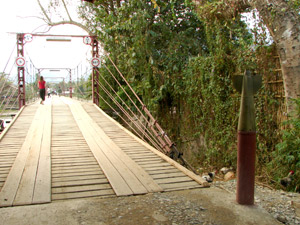 |
Web production
Hans-Peter Nilsson |

